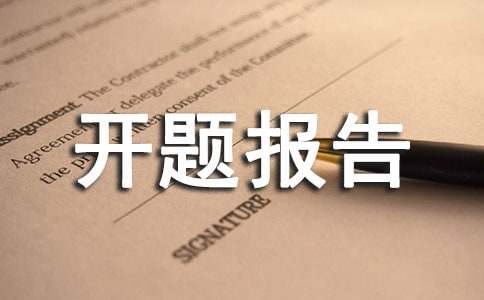- 相關推薦
開題報告英文篇
下面是一篇英語論文的開題報告范文,雖然不是特別好,但也反應了開題報告的格式和寫法,有一定的借鑒價值。

Function and Application of Descriptive Translation Studies1 Introduction
The intention of this study is to explore possible advantages of Descriptive Translation Studies as in its application in translation practice and translation analysis.
Since early 20th century, translation studies gradually broke away from the marginal status within other related disciplines and established itself as an empirical science. From then on, schools of thought have kept coming out and each claims its legitimacy for existence. Among these schools is Descriptive Translation Studies (DTS).
DTS approaches translation from an empirical perspective. Translation is viewed to be a social activity having significant importance in the receiving culture and for the target community. Therefore, translation is dealt with beyond the linguistic realization and language comparison, and is incorporated in social and cultural context.
My attention was first directed to DTS by its peculiar characteristic of observation, description and explanation. The subject is whatever happens in translation practice, from the determination of prospective function of translation to the process of translator’s choice of strategies, brainstorming and the revision, to the final product making appearance in the target community.
The method of DTS is basically descriptive. The prescriptive tendency and the problem-solution pattern is abandoned. Translation phenomena are noted down. With accumulated data, some underlying truths about translation will come out which will prove to be instructive not only for theoretical probe but also for applied translation practice. I will apply this descriptive method in the case study of this thesis.
A convenient tool has been set up to conduct DTS. “Norm” is operative at every stage of description and explanation. Function, process and product and their relationship as well are skeletal structure of what constitute descriptive studies. Translation phenomena are accounted for with the help of norm.
The case taken in this thesis is the Chinese classic The Dream of Red Mansions. Two English versions translated respectively by Yang Hsien-yi and David Hawks are compared and observations are made in regard to their translation approaches.
In this regard, my observations are limited to several aspects, I hope in-depth observation and explanation will done in light of DTS.
2 Outline
2.1 Development and major concepts of DTS
In this part I will describe Holms’ basic map of DTS and the relationship between function, process and product. I will also discuss some important concepts such as pseudo-translation, multiple translation, translationese, norm etc.
2.2 Methodolgy
I will in this part discuss the methodology of DTS before I apply the same to the case study in this thesis with emphasis to be placed on semiotic approach and the concept norm.
2.3 DTS in contrast to other theories
A contrast study will be conducted here with the objective to find the difference of DTS from other theories such as equivalence theory and the Chinese Xin Da Ya criteria. Some advantage will possibly be shown in this study.
2.4 Case study
In this part, translation of The Dream of Red Mansions (also translated as The Story of The Stone) will be under investigation in light of DTS. Translation samples to be quoted here will be selected at random.
2.5 Conclusion
Based on the above elaboration of DTS and the case study, possible conclusion will be on the advantage of DTS in specific study of translation. Suggestions on further research efforts will be made also.
(Note: While the topic will remain the same, the above arrangement of contents is subject to change in the process of writing.)
000
附錄2- 引文范例(僅供參考)
“It is therefore pointless to try to make TC more scientific than is sensible in view of its complex subject-matter and available methods. Translating is a mental, multi-factorial activity which cannot exhaustively be investigated within a linguistic framework ignoring the person of the translator.”(Wilss, 1982: 217)
‘“噢,這就是恐水病吧?你們貴族圈子怎么流行起這種病來啦?真夠嗆的!費芬斯小姐,您喝點茶大概沒關系吧!”’(張南峰,1990:59-60)
附錄3- 參考文獻范例(僅供參考)
Wilss, Wolfram. The Science of Translation – Problems and Methods. Gunter Narr Verlag Tubingen,1982.
Newmark, Peter. A Textbook of Translation. New York: Prentice Hall, 1988.Delabastita, Dirk. Translating Puns: A false Opposition in Translation Studies. Target, 1991(3:2):137-152.
[開題報告英文篇]相關文章:
1.商英專業畢業論文開題報告范文
2.國際經濟英與貿易專業論文開題報告范文
3.課題開題報告格式與開題報告的寫法
4.有關開題報告課題來源的開題報告文章
5.解讀開題報告格式與開題報告寫作技巧
6.開題報告的格式與開題報告的寫作技巧全文
7.論文開題報告格式
8.大學課題開題報告
9.建筑專業開題報告
10.2016論文開題報告
【開題報告英文篇】相關文章:
教育開題報告03-25
開題報告怎么寫11-25
金融開題報告范文12-31
撰寫開題報告的意義及方法08-14
個人網站設計開題報告03-28
教育課題開題報告(精選10篇)07-24
學前教育美術的開題報告03-28
甜品包裝設計開題報告03-26
碩士生開題報告范文12-31
小學閱讀教學開題報告(精選12篇)09-13